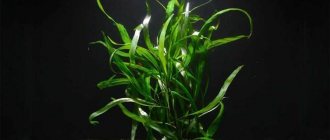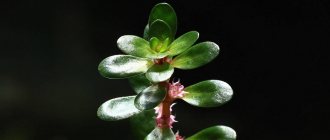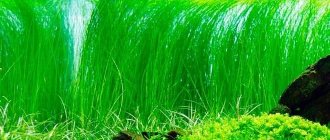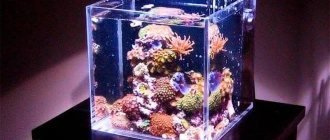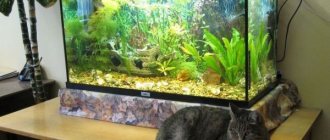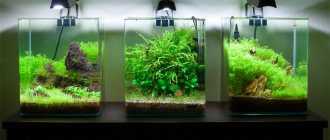Description and characteristics of the plant
Ceratopteris thalictroides is the scientific name of the Indian fern. With proper care, it can grow up to 0.4-0.5 m in height and turn into a lush, beautiful bush.
All varieties of water fern are characterized by:
- well branched root system;
- thick stem;
- many graceful branches strewn with finely dissected leaves.
The characteristic features of the Indian fern are branched roots and many branches with finely dissected leaves.
The color of plants depends on lighting, water hardness and chemical parameters of the habitat. Most varieties have dominant green, dark green and bluish-green shades.
Watering
The curly fern (in the photo you can see how good this beauty is) needs to be watered in excess, avoiding dry periods. It should not be brought to such a state that the soil around the rhizome turns into a lump - it should always remain loose and moist.
During the period when the plant reduces activity, the amount of water must be reduced, but watering cannot be stopped completely.
You need to take soft water - melted or filtered, without lime and other impurities.
Overmoistening, in turn, can lead to damage to the roots, so the water from the pan must be drained.
Types of Indian Fern
To decorate the underwater landscape, aquarists use several varieties of ferns that are most adapted to the conditions of closed ecosystems, among them:
- Wing-shaped, or water cabbage. Under natural conditions, it lives in stagnant and slow-flowing reservoirs of South and Central America. Grows in height up to 30-40 cm. Can be grown as a floating or planted plant. Water cabbage leaves are a natural biofilter, light diffuser and shelter for fry.
- Lace. The name of this fern speaks for itself - its long leaves with large and multiple cuts look like openwork lace. Distributed in Indonesia and Sri Lanka. The height of compact light green bushes varies from 15 to 38 cm. They are distinguished by the rapid growth of green mass.
- Thai. Whole, wrinkled, elongated, lanceolate, dark green leaves reach a length of 15-30 cm. They grow from a long, creeping rhizome. The plant will do well in any corner of the aquarium.
- Shchitovnikovy, or Bolbitis. Unlike the Indian one, it extends not upward, but in width, occupying the lower tier of the aquarium. The dark green, complex pinnate leaves are arranged alternately. It is capable of vegetating not only in the ground, but also on stones, clinging to support with its rhizoid roots.
The leaves of the Thai fern can reach 30 cm in length.
Ferns differ from each other in habit (appearance) and growth rate. But they all come from tropical waters, so the growing conditions for ceratopteris are the same.
Soil selection
For normal growth, indoor curly fern needs a light soil mixture rich in nutrients. To do this, you need to mix three components in equal parts - peat, greenhouse soil (or coniferous soil), and sand.
You can purchase a ready-made substrate for ferns. It is used both in its original form and enriched with peat and sand. Drainage must be placed at the bottom of the container - expanded clay or small pieces of coniferous tree bark (mainly pine).
Keeping in an aquarium
Indian Ceratopteris is a plant with high adaptability and endurance; it can exist for a long time and not die in an unfavorable environment. But for normal development and active growth, it needs to be provided with optimal conditions. Factors that influence the health and appearance of a fern include light intensity, the structure of the planting substrate and water parameters. They must have the following characteristics:
- Priming. The roots of the plant are powerful and branched, but fragile and brittle. Therefore, the substrate must be soft. Coarse sand can be used as a support for the root system of the fern; any silted substrate laid on the bottom in a layer of 4-5 cm is also suitable.
- Lighting. Ceratopteris can grow in shade, but it thrives best in bright light. This can be natural or artificial light. In the first case, direct rays of the sun should not fall on the bush, otherwise burns will remain on the delicate leaves. In the second case, you need to use LB type fluorescent lamps, which reproduce sunlight in color. The design power of the lamps should be 0.4-0.5 W per 1 liter of water, and the duration of daylight hours should be at least 12 hours.
- Water temperature. The fern develops well at temperatures in the range of +22...+27°C, so it is suitable for an aquarium with heat-loving fish. The plant can adapt to cooler temperatures (20°C and below), but in such conditions it will stop growing and its leaves will become smaller.
- Chemical composition of water. Ceratopteris does not tolerate hard water with an alkaline reaction. It needs a soft, neutral or slightly acidic environment with hardness ≤ 6° and acidity 5-6.5.
When keeping Indian fern in an aquarium, you need to take into account several factors: soil, water temperature and its chemical composition, as well as lighting.
Ceratopteris thalictroides receives all its nutrients from soil, silt and water, and does not need additional fertilizing with fertilizers. The flower grows better in old water with a high concentration of humic acids formed during the decomposition of organic residues. Therefore, there is no need to change the water in the aquarium often.
Ceratopteris is able to efficiently purify the water in the tank and prevent the development of weed algae. If other inhabitants of the reservoir can do without a filter and aerator, then these devices do not need to be installed specifically for growing ferns.
Beneficial features
Different types of curly fern are used for indoor landscaping. This is a fairly unpretentious plant that grows well in warm and bright apartments and offices. In addition to the pleasure that comes from seeing lush green leaves, ferns have beneficial properties. It cleans the air well, absorbing harmful toluene and formaldehyde from the atmosphere, which is especially important for high-traffic areas - classrooms, offices, hallways in commercial buildings.
There is also an opinion that indoor curly fern neutralizes various microbes that cause diseases. These useful qualities only add to its attractiveness in the eyes of all lovers of home gardening.
Indian fern propagation method
You can get a new Indian fern bush by dividing. Divide a fairly large bush into parts by carefully cutting its rhizome. In order for the divisions to quickly take root and be able to independently obtain nutrients, each plant must have a strong root system and several shoots. The cuttings can be planted elsewhere, given to friends or sold.
There is another simple way to propagate water fern. From the accessory axils of the leaves of adult specimens, daughter rosettes periodically appear, which form their own root system and several leaves. Over time, the daughter plant separates from the mother leaf and floats to the surface of the reservoir. If left undisturbed, it will continue to develop as a floating variety, and if planted in the ground, it will quickly take root.
Air humidity
House curly fern loves high humidity. In optimal temperature conditions, the plant will grow well even with reduced air humidity in the room, which is typical for residential premises during the heating season. If temperatures are higher than normal or approaching a dangerous limit, your green pet needs to be sprayed more often - ideally every day. To do this, use soft melted or filtered water.
When it gets too hot and the room temperature goes through the roof, the fern needs to find a new place, where it will be covered in deep shade.
To maintain optimal humidity, the pot is often placed in a wide tray, which is covered along the edges with drainage (expanded clay) or rolled with moss. This filler, sprinkled with water, takes a long time to evaporate the moisture the plant needs.
Cool temperatures and high humidity can cause the fern to become susceptible to fungus, so this is a bad combination of factors to avoid.
Compatibility with other aquarium inhabitants
The extensive but fragile root system of the Indian fern, when growing, can become intertwined with the roots of other plants, suffer from damage or lack of nutrients. Therefore, it is advisable to use bushes with carved foliage as tapeworms and plant them away from green thickets.
Another option to protect the delicate and fragile roots of the fern is to plant the bushes in separate pots. This trick will help prevent different root systems from intertwining or being damaged by fish digging up the soil. The inhabitants of the reservoir, who prefer to spawn in dense thickets, will feel good next to the lush, openwork bush.
Bookmarks 0
Temperature
In order for the plant to remain healthy, grow well and have an attractive appearance, you need to know how to care for a curly fern. This is a tropical plant, but it also does well in moderate temperatures. The optimal mode is 20 ⁰C all year round. The maximum permissible values are 28 ⁰С. Minimum – not lower than 14 ⁰С. Exceeding this temperature range can lead to complications. If the air in the room is hotter than necessary, the fern needs to be sprayed more often. The plant does not tolerate being near heat sources - central heating radiators and stoves.
Transfer
Indoor curly fern must be replanted after purchase, since it is sold in a specific nutrient substrate that is unsuitable for long-term use. After the purchase, 10-15 days should pass, after which the plant must be moved to a larger pot and in proper suitable soil. After the fern has taken root, you can begin to introduce fertilizing.
Adult specimens are transplanted once a year, in the spring, into a larger container. In this case, it is advisable to free the roots from the clod of earth, although this procedure can damage them.
Nephrolepis exaltata
He is the founder of many varieties of indoor ferns that are grown at home. Nephrolepis sublime is the most popular variety. It has long leaves, they are called fronds. Refers to plants growing on the surface of the soil.
It is recommended to keep the plant on hanging shelves so that the fern leaves hang down beautifully. They can reach up to 70 cm in length. The fronds are divided into small segments 5 cm long. In the natural environment, it is found in Southeast Asia. The most commonly purchased of its varieties is Nephrolepis Boston.
Nephrolepis curly
Another variety that was created based on nephrolepis exaltata. It is characterized by dark green leaves that arise from rhizoids - small roots for attachment to the ground.
The fronds are long, about 60 cm in length, and consist of small plates, pointed in shape, with wavy edges. It is often grown at home; nephrolepis curly looks impressive when hung.

